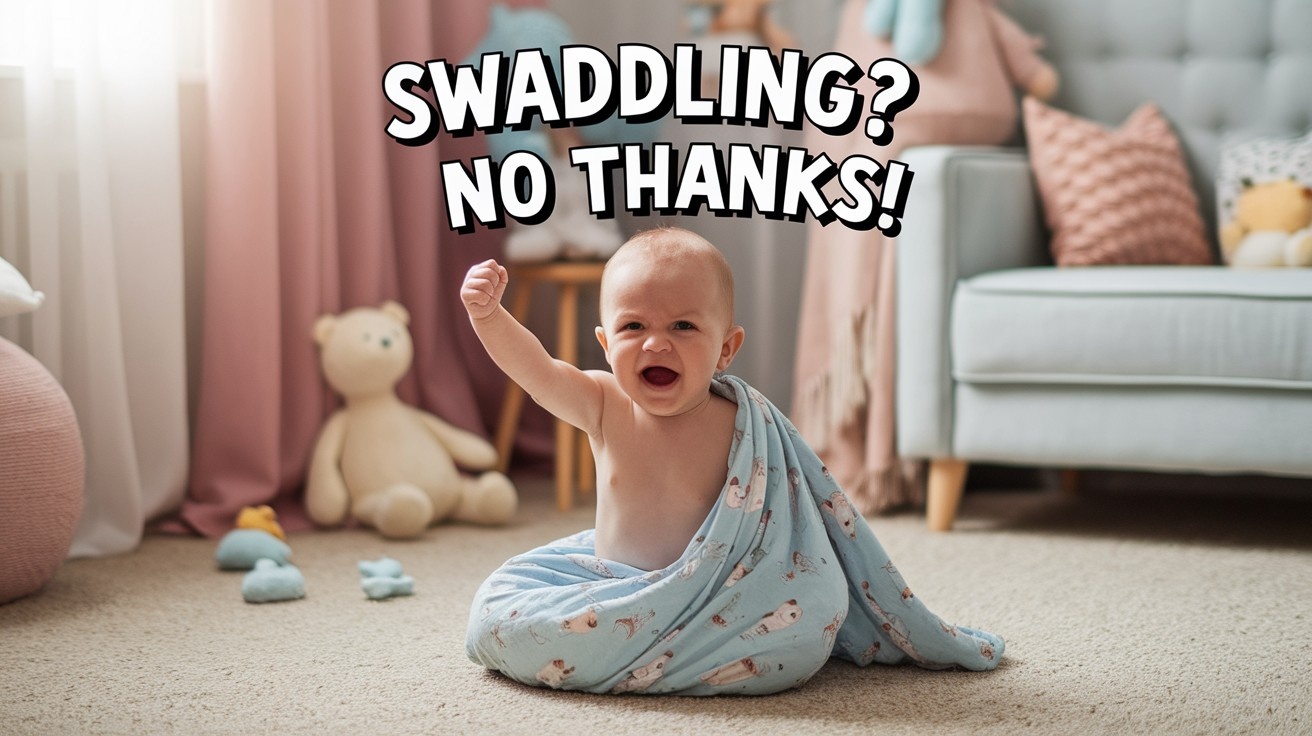
Tiny arms flailing wildly, face turning crimson, and those heart-wrenching cries that seem to say, “Get me out of here!”
While swaddling works like magic for many infants, changing them into peaceful sleeping bundles, some babies fight it with surprising determination.
Swaddling—the age-old practice of wrapping babies snugly in a thin blanket—mimics the secure feeling of the womb and can trigger a calming reflex in newborns.
Did you know? Archaeological evidence suggests that parents have been swaddling babies for over 4,000 years!
Yet, for some parents, the technique that everyone raves about becomes a source of frustration when their little one protests strongly.
If your baby seems to hate being swaddled, you’re not alone, and there’s nothing wrong with either your technique or your baby.
Let’s explore why this happens and what alternatives might work better for your unique little human.
Why Do Babies Usually Like Swaddling?
Babies typically enjoy swaddling because it triggers their innate calming reflex by mimicking the snug environment of the womb, providing a sense of security and protection similar to their pre-birth experience.
This gentle pressure helps transition newborns to life outside while preventing the startling Moro reflex from disrupting sleep.
Swaddling also regulates temperature and provides comforting boundaries in an otherwise overwhelming world, often resulting in longer sleep stretches and reduced fussiness.
Though most infants respond positively to this technique, each baby has unique preferences—some prefer having their arms free while others need complete wrapping.
Parents should observe their baby’s cues, adjust swaddling methods as needed, and eventually modify or discontinue the practice as their baby develops greater mobility and different developmental needs.
Is It Normal That Your Baby Hates Swaddle?

Many parents worry when their baby resists swaddling, but this is actually quite common. Some babies naturally prefer freedom of movement from birth, displaying their unique preferences right from the start.
Your baby’s dislike of swaddling often aligns with developmental milestones.
As they grow and find their hands or begin to roll, many babies will protest being confined, signaling they’re ready for different sleep solutions.
Every baby has their own personality and physical preferences. Some enjoy the snug feeling reminiscent of the womb, while others prefer space to stretch and wiggle.
Occasionally, swaddle resistance might indicate sensory sensitivities. If your baby seems genuinely distressed by certain fabrics or pressure, they may benefit from alternative soothing techniques that respect their sensory needs.
Signs Your Baby Hates Swaddle

Many babies find comfort in swaddling, but some infants make it clear they prefer freedom. Recognizing your baby’s discomfort early can help both of you get better sleep.
1. Crying or Fussing
If your baby consistently cries when swaddled, they might be communicating discomfort. This isn’t the normal newborn fussiness but rather a specific distress that begins with the swaddle.
Some babies prefer having their hands free to self-soothe by sucking their fingers or touching their face.
Trust your parental instincts—if crying intensifies with swaddling, it might be time to try alternative soothing methods.
2. Fighting to Break Free
A baby who constantly works to free their arms is sending a clear message. This persistent squirming isn’t random movement but purposeful resistance.
Many babies naturally sleep with their arms up by their heads, making traditional swaddling uncomfortable. Consider a transitional swaddle that allows arm movement while still providing comfort.
3. Disrupted Sleep Patterns
Swaddling should improve sleep, not hinder it. If your swaddled baby experiences more startles or shorter sleep cycles, the restriction might be causing stress.
Some babies need movement to settle themselves.
Watch for increased wakefulness or irritability after swaddling—these are signs your child might prefer alternative sleep solutions.
Why Your Baby Hates Being Swaddled

Swaddling, while comforting for many infants, isn’t universally loved. If your baby fusses or fights the swaddle, there could be several reasons behind their resistance.
1. Too Tight or Too Loose Wrap
A swaddle that’s wrapped too tightly can restrict breathing and movement, causing discomfort and frustration. Your baby may cry or struggle to signal their distress.
Conversely, a loose swaddle defeats the purpose, allowing the startle reflex to wake your baby and potentially creating unsafe loose fabric in the crib.
2. Fabric and Temperature Issues
Some babies are sensitive to certain materials, finding them scratchy or irritating against their soft skin. Pay attention to your baby’s reaction to different fabrics.
Overheating is another common concern, as babies can’t regulate their temperature well. Watch for signs like sweating, flushed cheeks, or rapid breathing that might indicate your swaddled baby is too warm.
3. Freedom of Movement
Some babies prefer having their arms and hands free to self-soothe. They may want to put their hands to their mouths or explore their surroundings.
This preference for movement is completely normal and may require adapting your swaddling technique to accommodate their preferences.
4. Transition Time
As babies develop, usually around 3-4 months, they naturally outgrow the need for swaddling. Rolling over is a clear sign that it’s time to transition away from traditional swaddling for safety reasons.
Consider transitioning gradually with arms-out swaddles or sleep sacks to help your baby adjust to this developmental milestone.
What to Do If Your Baby Hates Swaddle

Many babies feel secure when swaddled, but some resist this age-old comfort technique. If your little one struggles against being wrapped up, don’t worry—you have options.
Try different swaddling techniques first. Some babies prefer having their arms up rather than down by their sides.
Specialized products like Velcro swaddles or zip-up sleep sacks can provide a secure feeling without the complicated folding. These modern alternatives are designed with wiggly babies in mind.
Consider a gradual approach by swaddling only at specific times. Many parents find success using swaddles only during naps or nighttime sleep when babies need help settling down.
Swaddle alternatives like weighted sleep sacks or wearable blankets might be the perfect solution. These provide comfort and warmth without the restrictive feeling some babies resist.
Tips for Transitioning Out of Swaddle
Transitioning out of swaddling typically begins when babies show signs of rolling over, usually between 3 and 5 months. Start during a period of normal routine by freeing one arm for a few days, then both arms, before moving to a sleep sack.
Begin with naptimes first, as they’re shorter and easier to manage.
Maintain a consistent bedtime routine to provide security during this change, and consider introducing a safe comfort object to replace the snug feeling of the swaddle.
Using a transitional product like a sleep sack with wing-like wraps can ease the process.
Be patient through temporary sleep disruptions, as your baby needs time to adjust to their new freedom. Many parents find success by making subtle temperature adjustments to ensure comfort without the extra layer of swaddling.
Pro tip: Consider using white noise during the transition period to help mask the new sensations of movement and provide a consistent sound cue that signals sleep time.
When to Talk to Your Pediatrician
Persistent sleep issues in babies often warrant professional attention, especially when accompanied by crying, arching, or pulling legs to the chest, as these may indicate underlying problems beyond typical developmental phases.
Your pediatrician can help distinguish between normal patterns and problems requiring intervention while also addressing concerns about missed developmental milestones in physical, cognitive, or social areas.
Pay attention to how your baby responds to sensory experiences like sounds, textures, lights, or movement. Unusual sensitivities could indicate processing differences that benefit from professional guidance.
Trust your parental instincts—your observations provide valuable information that helps healthcare providers deliver appropriate care customized to your child’s unique needs.
Final Words
Every baby has unique preferences, and it’s perfectly normal if your little one resists swaddling. Listen to your baby’s cues and adapt accordingly.
Different babies require different soothing methods. What works for one infant may not work for another, and that’s completely okay.
Remember that your parenting trip is uniquely yours. Trust your instincts when determining what helps your baby sleep peacefully.
If traditional swaddling causes distress, try alternative methods like sleep sacks, arms-up swaddles, or gradual weaning techniques. Many parents find success with these adaptations.
Most importantly, don’t be discouraged. Better sleep is absolutely possible without swaddling. With patience and flexibility, you’ll find what works best for your family’s sleep routine.
If you’re interested in more informational content on mothers and babies, feel free toclick here and explore other blogs that you might enjoy.
